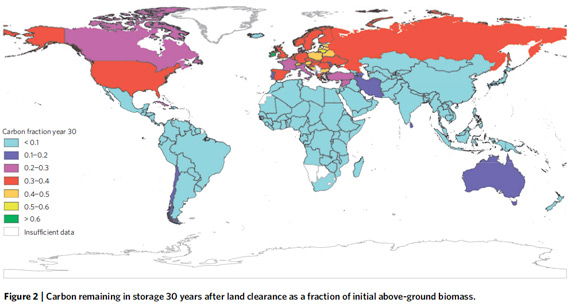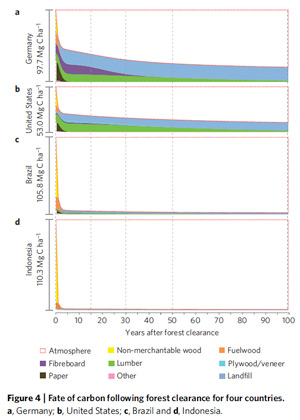
Carbon remaining in storage 30 years after land clearance as a fraction of initial above-ground biomass. Courtesy of Earles et al 2012. Click image to enlarge.
Carbon emissions from deforestation vary greatly depending on whether timber stocks are turned into finished wood products, converted into bioenergy feedstocks, or burned outright, reports a new study published in Nature Climate Change.
The research looked at forest use in 169 countries. It found that foresters in temperate countries typically convert forests into timber products that store carbon for generations, whereas developers in the tropics are more likely to clear forests for energy or paper production, short-lived products which release carbon more immediately. Further a significant proportion of tropical forests are burned for agricultural use.
“Carbon stored in forests outside Europe, the USA and Canada, for example, in tropical climates such as Brazil and Indonesia, will be almost entirely lost shortly after clearance,” write the authors. “For 90 countries, less than 5% of carbon remains after 30 years, whereas 34 countries have more than 25% in storage.”
The authors cited representative examples from Germany, the United States, Brazil, and Indonesia. In Germany and the U.S. less than half of forest biomass is burned immediately after harvesting, while more than a quarter ends up in durable wood products. In Indonesia and Brazil only a small fraction of forest carbon ended up being stored in wood products.
 Fate of carbon following forest clearance for four countries. a, Germany; b, United States; c, Brazil and d, Indonesia. Click image to enlarge. |
“Germany and the United States represent countries in which carbon stored in wood products may substantially reduce the GHG effects of forest clearanceespecially under shorter time horizons,” they write.
“[Brazil and Indonesia] have high initial above-ground live biomass stocks owing to their mostly dense tropical forests. Land clearance rapidly releases this carbon to the atmosphere as most of the wood is either non-merchantable or used as fuelwood. Forest products capable of longer-term storage represent a very small fraction of the total above-ground live biomass carbon of these countries.”
“Consequently, the GHG effects owing to forest clearance in countries such as Indonesia and Brazil will be dampened little by long-term storage of biomass in wood products.”
TThe research is significant because it may help refine models used to determine emissions from deforestation.
“We found that 30 years after a forest clearing, between 0 percent and 62 percent of carbon from that forest might remain in storage,” said lead author J. Mason Earles, a researcher at the UC Davis Institute of Transportation Studies, in a statement. “Previous models generally assumed that it was all released immediately.”
“We hope it will give climate models some concrete data on emissions factors they can use.”
CITATION: J. Mason Earles, Sonia Yeh and Kenneth E. Skog. Timing of carbon emissions from global forest clearance. Nature Climate Change PUBLISHED ONLINE: 13 MAY 2012 | DOI: 10.1038/NCLIMATE1535
Related articles